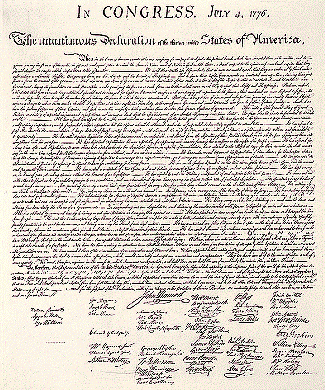The Declaration of Independence
 Drafted by Thomas
Jefferson between June 11 and June 28, 1776, the Declaration of
Independence is at once the nation's most cherished symbol of liberty
and Jefferson's most enduring monument. Here, in exalted and
unforgettable phrases, Jefferson expressed the convictions in the
minds and hearts of the American people. The political philosophy of
the Declaration was not new; its ideals of individual liberty had
already been expressed by John Locke and the Continental
philosophers. What Jefferson did was to summarize this philosopy in
"self-evident truths" and set forth a list of grievances against the
King in order to justify before the world the breaking of ties
between the colonies and the mother country. I invite you to read a
transcription of the complete text of
the Declaration.
Drafted by Thomas
Jefferson between June 11 and June 28, 1776, the Declaration of
Independence is at once the nation's most cherished symbol of liberty
and Jefferson's most enduring monument. Here, in exalted and
unforgettable phrases, Jefferson expressed the convictions in the
minds and hearts of the American people. The political philosophy of
the Declaration was not new; its ideals of individual liberty had
already been expressed by John Locke and the Continental
philosophers. What Jefferson did was to summarize this philosopy in
"self-evident truths" and set forth a list of grievances against the
King in order to justify before the world the breaking of ties
between the colonies and the mother country. I invite you to read a
transcription of the complete text of
the Declaration.
Important note: This image of the Declaration is
taken from the engraving made by printer William J. Stone in 1823 and
is the most frequently reproduced version of the document. The
original Declaration, now exhibited in the Rotunda of the National
Archives in Washington, DC, has faded badly--largely because of poor
preservation techniques during the 19th century. Today, this
priceless document is maintained under the most exacting archival
conditions possible.
To enrich your understanding of the Declaration of Independence, I
recommend:


This page hosted by  Get your own Free Home Page
Get your own Free Home Page
 Drafted by Thomas
Jefferson between June 11 and June 28, 1776, the Declaration of
Independence is at once the nation's most cherished symbol of liberty
and Jefferson's most enduring monument. Here, in exalted and
unforgettable phrases, Jefferson expressed the convictions in the
minds and hearts of the American people. The political philosophy of
the Declaration was not new; its ideals of individual liberty had
already been expressed by John Locke and the Continental
philosophers. What Jefferson did was to summarize this philosopy in
"self-evident truths" and set forth a list of grievances against the
King in order to justify before the world the breaking of ties
between the colonies and the mother country. I invite you to read a
transcription of the complete text of
the Declaration.
Drafted by Thomas
Jefferson between June 11 and June 28, 1776, the Declaration of
Independence is at once the nation's most cherished symbol of liberty
and Jefferson's most enduring monument. Here, in exalted and
unforgettable phrases, Jefferson expressed the convictions in the
minds and hearts of the American people. The political philosophy of
the Declaration was not new; its ideals of individual liberty had
already been expressed by John Locke and the Continental
philosophers. What Jefferson did was to summarize this philosopy in
"self-evident truths" and set forth a list of grievances against the
King in order to justify before the world the breaking of ties
between the colonies and the mother country. I invite you to read a
transcription of the complete text of
the Declaration.